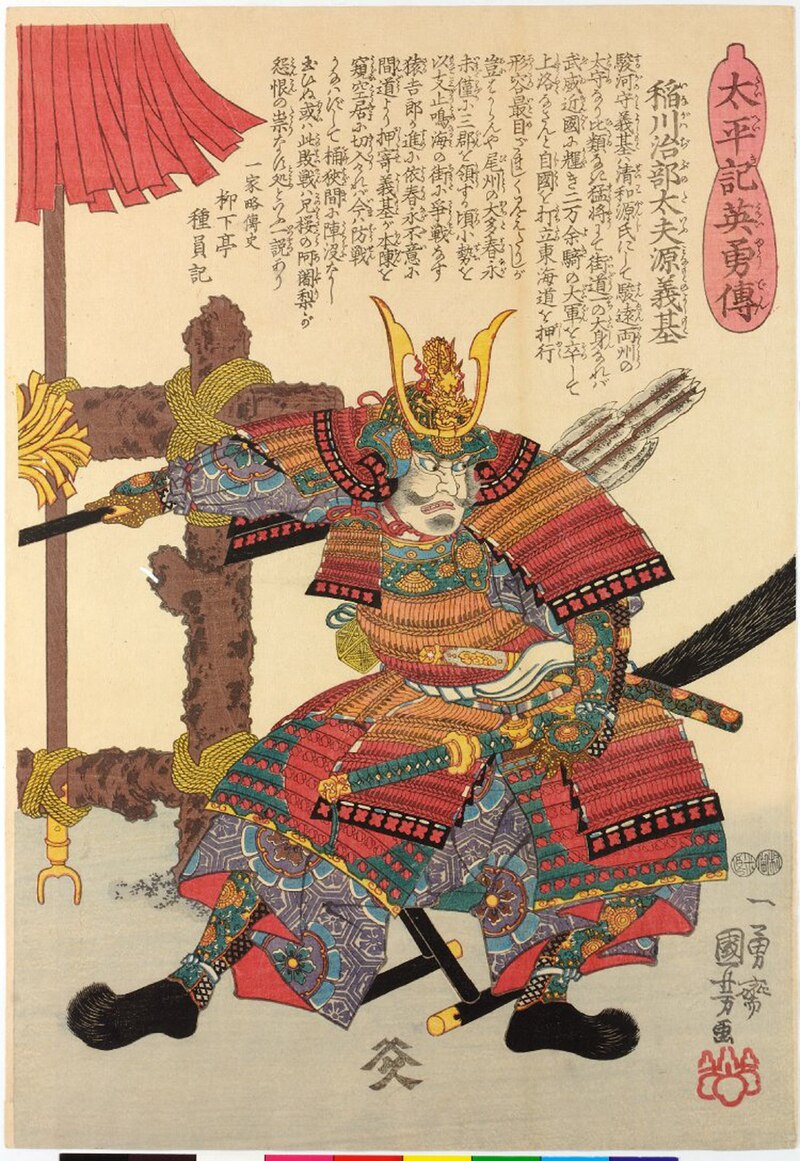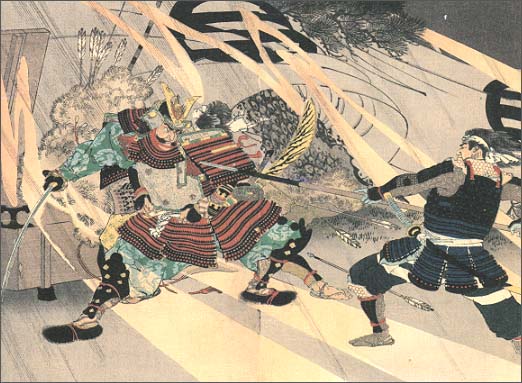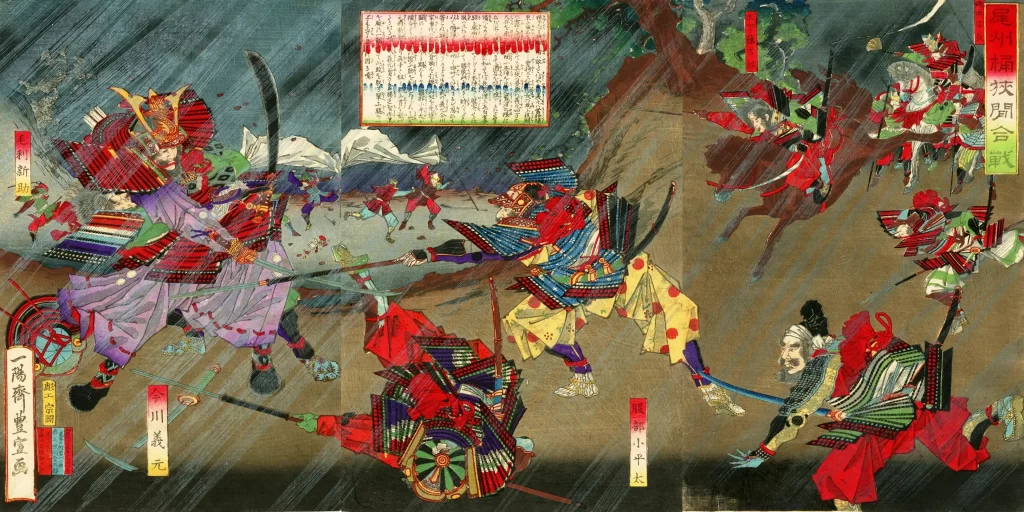Introduction
The Battle of Okehazama was a pivotal moment in Japanese history. It took place on June 12, 1560, during the Sengoku period. This battle marked the rise of Oda Nobunaga, a significant figure in Japanese history.
Imagawa Yoshimoto, a powerful daimyo, led a large army to capture Kyoto. His goal was to seize control of the country. Oda Nobunaga, the leader of the Oda clan, faced overwhelming odds. Despite this, he managed to turn the tide.
The Battle of Okehazama is famous for its strategic brilliance. Nobunaga’s surprise attack changed the course of history. This battle showed his military genius and boldness. It set the stage for his future conquests.
In this post, we will explore the key events of the battle. We will look at the strategies used and the impact of the battle. We will also examine the legacies of the main figures involved. Join us as we delve into this fascinating chapter of Japanese history.
Background Context
The Sengoku period was a time of chaos in Japan. It lasted from the mid-15th century to the early 17th century. During this time, powerful regional lords, known as daimyo, fought for control.
Oda Nobunaga was the head of the Oda clan. His domain was in Owari Province. Nobunaga was known for his ambition and unconventional tactics. He aimed to unify Japan under his rule.
Imagawa Yoshimoto was another powerful daimyo. He ruled the Suruga, Totomi, and Mikawa provinces. Yoshimoto had a strong, well-equipped army. His goal was to march to Kyoto and take control of the Shogunate.
In 1560, Yoshimoto launched a major campaign. He led a force of about 25,000 men towards Kyoto. Nobunaga, on the other hand, had only about 2,000 to 3,000 troops. Despite the odds, Nobunaga decided to confront Yoshimoto.
The political landscape was tense. Many smaller clans were watching the conflict closely. They were waiting to see which side would come out on top. The outcome of this battle would influence the power dynamics in the region.
Understanding the context helps us appreciate the stakes of the Battle of Okehazama. It was more than just a clash of armies. It was a turning point in the quest for dominance in Japan.
Prelude to the Battle

In May 1560, Imagawa Yoshimoto set out on his ambitious campaign. His goal was to capture Kyoto and become the dominant force in Japan. Yoshimoto’s army was large and confident. They moved through the provinces with little resistance.
Oda Nobunaga, leader of the Oda clan, faced a daunting challenge. His forces were vastly outnumbered. Nobunaga knew he needed a bold strategy to succeed. He decided to take a high-risk approach.
Yoshimoto’s army camped at a place called Dengakuhazama. They believed they were safe. They celebrated their recent victories. The camp’s mood was relaxed and confident.
Nobunaga saw an opportunity. He gathered intelligence on Yoshimoto’s movements. Nobunaga planned a surprise attack. He chose a small, elite force for this mission. Speed and surprise were crucial.
On June 11, Nobunaga left Kiyosu Castle. He led his men through difficult terrain. Heavy rain provided cover for their movements. Nobunaga’s troops reached a position close to Yoshimoto’s camp.
The stage was set for the Battle of Okehazama. Nobunaga’s bold plan would soon unfold. The outcome would reshape the power structure of the Sengoku period. The prelude to the battle was a testament to Nobunaga’s strategic genius.
The Battle Unfolds
On the morning of June 12, 1560, Oda Nobunaga’s forces were in position. The rain continued to fall, masking their approach. Yoshimoto’s camp remained unaware of the impending attack.
Nobunaga’s troops launched a surprise assault. They stormed into Yoshimoto’s camp with ferocity. The Imagawa soldiers, caught off guard, were thrown into chaos.
The terrain played a crucial role. Nobunaga’s forces used the hills and ravines to their advantage. They moved swiftly and struck hard. The rain and fog added to the confusion among Yoshimoto’s men.
Imagawa Yoshimoto, believing his camp was secure, was initially oblivious to the attack. When he realized what was happening, it was too late. Yoshimoto tried to rally his troops, but the disarray was too great.
Nobunaga’s elite warriors pressed the attack. They aimed for Yoshimoto’s command tent. In the midst of the chaos, Yoshimoto was killed by Nobunaga’s men. His death marked the turning point of the battle.
The remaining Imagawa forces, leaderless and demoralized, began to flee. Nobunaga’s victory was swift and decisive. The battle lasted only a few hours, but its impact was immense.
The surprise attack demonstrated Nobunaga’s daring and tactical brilliance. He had turned the tide against a much larger force. The Battle of Okehazama showcased his ability to outthink and outmaneuver his enemies.
The aftermath saw the collapse of Imagawa Yoshimoto’s campaign. Nobunaga’s bold strategy had changed the course of history. The Battle of Okehazama was a defining moment in the Sengoku period. It cemented Nobunaga’s reputation as a formidable leader and strategist.
Key Moments and Turning Points
Several key moments and turning points defined the Battle of Okehazama. These events highlight the brilliance of Nobunaga’s strategy and the swift downfall of Yoshimoto’s campaign.
1. The Decision to Attack
- Nobunaga’s decision to confront a much larger force was the first critical moment. Despite being outnumbered, he chose a high-risk, high-reward strategy. This bold move set the stage for the battle.
2. Use of Terrain and Weather
- Nobunaga utilized the terrain and weather conditions to his advantage. The hills and ravines around Dengakuhazama provided cover for his troops. The heavy rain on the day of the attack masked their approach, adding an element of surprise.
3. The Surprise Assault
- The sudden and fierce attack on Yoshimoto’s camp was the turning point of the battle. Nobunaga’s troops struck with speed and precision. The Imagawa forces were caught completely off guard, leading to immediate chaos and confusion.
4. Yoshimoto’s Initial Reaction
- Initially, Imagawa Yoshimoto was unaware of the true nature of the attack. He mistook it for a minor skirmish. When he realized the severity of the situation, it was already too late. His delayed reaction contributed to the disarray among his troops.
5. Yoshimoto’s Death
- The death of Imagawa Yoshimoto was a decisive moment. Nobunaga’s men managed to breach the command tent and kill Yoshimoto. This demoralized the Imagawa forces and led to their rapid collapse.
6. Collapse of Imagawa Forces
- After Yoshimoto’s death, the remaining Imagawa soldiers lost their will to fight. Leaderless and in disarray, they fled the battlefield. Nobunaga’s forces pursued them, ensuring a complete rout.
7. Nobunaga’s Leadership and Tactics
- Throughout the battle, Nobunaga’s leadership and tactical decisions were exemplary. His ability to execute a well-planned surprise attack against a larger force demonstrated his military genius. This battle solidified his reputation as a brilliant strategist.
The key moments and turning points of the Battle of Okehazama highlight Nobunaga’s strategic brilliance. His ability to exploit the element of surprise, use terrain and weather to his advantage, and decisively defeat a superior force marked this battle as a turning point in Japanese history.
Aftermath and Consequences
The Battle of Okehazama had profound and far-reaching consequences for Japan. The aftermath of this pivotal battle reshaped the political landscape and set the stage for Oda Nobunaga’s rise to power.
1. Immediate Consequences for the Oda Clan
- The victory at Okehazama greatly boosted the morale and prestige of the Oda clan. Nobunaga’s bold strategy and decisive win earned him widespread recognition. His reputation as a brilliant and daring leader was solidified.
2. Collapse of the Imagawa Clan
- The death of Imagawa Yoshimoto and the defeat of his army marked the beginning of the decline of the Imagawa clan. Without their powerful leader, the clan struggled to maintain its previous dominance. Many of Yoshimoto’s retainers either defected to other clans or were absorbed by rival forces.
3. Shift in Power Dynamics
- The power vacuum left by the Imagawa’s defeat allowed other regional lords to expand their influence. Notably, Tokugawa Ieyasu, who was previously a vassal of the Imagawa, seized the opportunity to assert his independence and later allied with Nobunaga. This alliance would prove crucial in the unification of Japan.
4. Nobunaga’s Rise to Prominence
- The victory at Okehazama was a turning point for Nobunaga. It set him on a path to greater power and influence. Nobunaga’s success attracted new allies and supporters, strengthening his position and enabling him to pursue his ambition of unifying Japan.
5. Influence on Military Strategy
- The Battle of Okehazama demonstrated the effectiveness of surprise tactics and unconventional warfare. Nobunaga’s innovative approach inspired future military leaders to think beyond traditional strategies. This battle is often studied for its lessons in leadership, risk-taking, and tactical innovation.
6. Long-term Impact on the Sengoku Period
- The defeat of a major daimyo like Imagawa Yoshimoto disrupted the existing balance of power. It accelerated the ongoing conflicts and realignments among the various clans. The Sengoku period, characterized by constant warfare and shifting alliances, saw a significant change in momentum after Okehazama.
7. Nobunaga’s Path to Unification
- The victory laid the groundwork for Nobunaga’s future campaigns. Over the next few years, he continued to expand his territory and influence. His leadership would eventually pave the way for the unification of Japan under the Tokugawa Shogunate, with his successors completing the task.
The Battle of Okehazama was more than just a military victory; it was a catalyst for change in Japan’s political and social structure. Nobunaga’s triumph not only secured his position as a formidable leader but also set in motion the events that would lead to the eventual unification of Japan. The aftermath of this battle had lasting repercussions that shaped the course of Japanese history.
Legacy of the Battle of Okehazama

The Battle of Okehazama holds a significant place in Japanese history. Its legacy is marked by the impact on military strategy, the rise of Oda Nobunaga, and its cultural resonance. Here are the key aspects of its legacy:
1. Demonstration of Tactical Brilliance
- The battle is renowned for Nobunaga’s innovative use of tactics. His surprise attack against a much larger force is a classic example of military ingenuity. This approach influenced future military leaders in Japan and beyond, showcasing the importance of strategy over sheer numbers.
2. Oda Nobunaga’s Rise to Power
- Okehazama was a turning point for Nobunaga, solidifying his reputation as a brilliant and daring leader. This victory was the first major step in his campaign to unify Japan. Nobunaga’s success at Okehazama paved the way for his subsequent conquests and the eventual unification of Japan under the Tokugawa Shogunate.
3. Shift in the Sengoku Period
- The defeat of Imagawa Yoshimoto disrupted the existing power balance. It accelerated the decline of the Imagawa clan and allowed other ambitious leaders to rise. This shift in power dynamics contributed to the intensification of conflicts during the Sengoku period, ultimately leading to the unification efforts of the late 16th century.
4. Influence on Future Generations
- The Battle of Okehazama is studied in military academies for its lessons in leadership and strategy. Nobunaga’s ability to take calculated risks and his innovative approach to warfare continue to inspire military strategists and historians.
5. Cultural Resonance
- The battle is a popular subject in Japanese literature, theater, and film. Stories of Nobunaga’s daring and the dramatic events of the battle are depicted in countless works, reflecting its enduring place in Japanese culture. It symbolizes the triumph of ingenuity and courage over seemingly insurmountable odds.
6. Symbol of Nobunaga’s Legacy
- The battle represents the beginning of Nobunaga’s legacy as one of Japan’s great unifiers. His vision and determination to overcome the fragmented state of Japan started with this crucial victory. Okehazama is often seen as the moment when Nobunaga’s destiny to reshape Japan became evident.
7. Historical Interpretations
- Historians view the battle as a critical juncture in the Sengoku period. It exemplifies the volatility and unpredictability of the era. The success of Nobunaga’s small force against a much larger army is often cited as a turning point that highlighted the changing nature of warfare during this time.
8. Commemoration and Memorials
- The site of the Battle of Okehazama is a historical landmark. Monuments and museums commemorate the battle and honor the legacy of those who fought there. These sites attract historians, tourists, and enthusiasts, preserving the memory of this pivotal event.
The legacy of the Battle of Okehazama is multifaceted, encompassing military strategy, historical significance, cultural impact, and the rise of one of Japan’s most influential leaders. It remains a symbol of strategic genius and a turning point in the history of Japan.
Conclusion
The Battle of Okehazama stands as a remarkable event in Japanese history. This clash, marked by Oda Nobunaga’s daring and innovative tactics, was a turning point during the Sengoku period. Despite facing overwhelming odds, Nobunaga’s strategic brilliance led to a decisive victory over Imagawa Yoshimoto.
The aftermath of the battle reshaped the political landscape. Nobunaga’s rise to prominence set the stage for his future campaigns and the eventual unification of Japan. The collapse of the Imagawa clan altered the balance of power, paving the way for new alliances and rivalries.
The legacy of Okehazama extends beyond its immediate consequences. It serves as a testament to the power of strategy and leadership. The battle is celebrated in Japanese culture and remembered as a symbol of courage and ingenuity. Nobunaga’s triumph at Okehazama continues to inspire and influence military strategists and historians.
In reflecting on the Battle of Okehazama, we see the enduring impact of one man’s vision and determination. Nobunaga’s victory was not just a military success; it was a defining moment that shaped the course of Japanese history. As we study this pivotal event, we gain insights into the dynamics of power, the art of war, and the legacy of a leader who dared to defy the odds.
References and Further Reading
Books:
- “Oda Nobunaga: The Battle of Okehazama” by Yoshikawa Eiji
- This book provides a detailed account of Nobunaga’s rise to power and the strategic brilliance displayed at the Battle of Okehazama.
- “Samurai: The Way of the Warrior” by Stephen Turnbull
- A comprehensive overview of the samurai era, including detailed chapters on the Sengoku period and key battles like Okehazama.
- “The Samurai Sourcebook” by Stephen Turnbull
- This book is a valuable resource for understanding the broader context of samurai warfare, including detailed descriptions of various battles and the strategies employed.
- “The Imagawa Clan: Power and Decline” by Hiroshi Kato
- Offers an in-depth look at the Imagawa clan, their rise to power, and their eventual decline, with significant focus on the Battle of Okehazama.
Articles:
- “The Surprise Attack at Okehazama: Tactical Brilliance and Military Strategy” in the Journal of Asian History
- An academic analysis of Nobunaga’s tactics and the impact of the battle on subsequent military strategies.
- “Nobunaga’s Bold Move: How the Battle of Okehazama Changed Japan” in History Today
- A concise article discussing the significance of the battle and its lasting effects on Japanese history.
Documentaries:
- “Nobunaga: The Fool Who United Japan”
- A documentary that explores Oda Nobunaga’s life, with a segment dedicated to the Battle of Okehazama, highlighting his strategic genius.
- “Samurai Battles: The Clash at Okehazama”
- This documentary provides a detailed reenactment of the Battle of Okehazama and its historical context.
Websites:
- Samurai Archives
- www.samurai-archives.com
- A comprehensive resource for information on samurai history, including detailed entries on key battles and figures.
- Japan Guide: Historical Sites
- www.japan-guide.com
- Offers information on visiting the Battle of Okehazama site and other historical landmarks related to the Sengoku period.
Further Exploration:
- Visiting Historical Sites:
- The Okehazama battlefield site in Aichi Prefecture offers a firsthand look at where this pivotal event took place. Monuments and museums provide detailed information about the battle and its significance.
- Academic Courses:
- Many universities offer courses on Japanese history and the Sengoku period. Enrolling in these courses can provide deeper insights and a structured learning experience.
By exploring these resources, readers can gain a comprehensive understanding of the Battle of Okehazama, its historical context, and its lasting impact on Japan.

